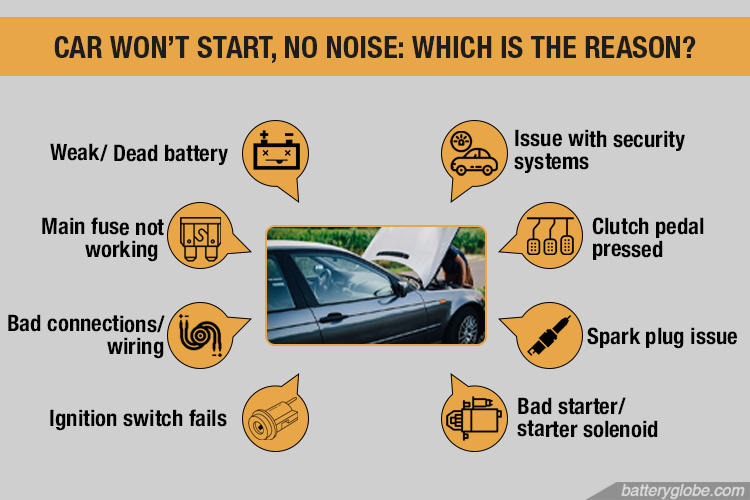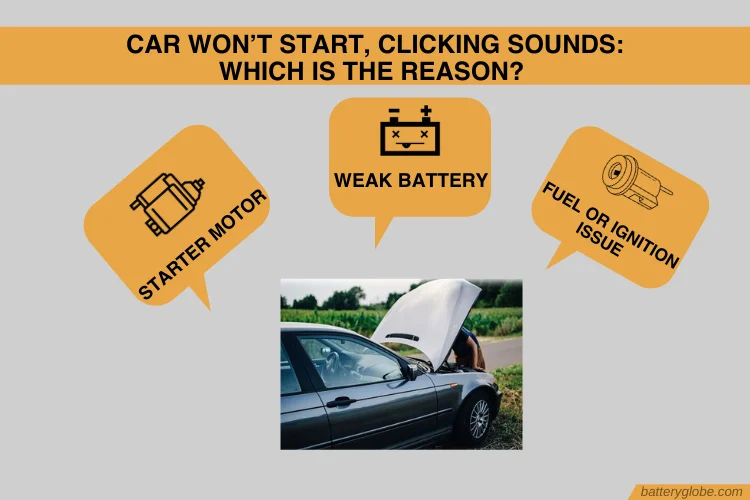We all rely on our cars so much these days that when you jump in, turn the key, and nothing happens, it can ruin your day. This article will look at the most common cause of your engine not cranking when turning the ignition key. We will also give you some tips on problem-solving and finding the cause of your engine not cranking.
Car Won’t Start – No Noise

Car won’t start no noise, nothing works
Suppose absolutely nothing on your car will work. In that case, there are probably two main possibilities: the battery is completely dead, or the main fuse has blown. Both are easy to diagnose and fix, but both give the same symptoms.
1. Dead battery
If you have a multimeter, you can quickly check the voltage of the battery. Any reading below 12 volts means this is probably your problem. If you don’t have a multimeter, try using jump leads or a battery booster to get some power to your car. If that works, then your battery will need either charging or replacing.
Charging your battery is best done using an advanced battery charger and maintainer, which recharges and reconditions your battery. A good charger/maintainer will cost from around $50 upwards, depending on the size of your battery.
If your battery is completely dead and needs replacing, then again, the cost will depend on your battery, but expect to pay from $75 upwards.
Buy advanced battery charger and maintainer here:
NOCO GENIUS5, 5-Amp

CTEK – 40-206 MXS 5.0

2. Main fuse (or wires) not working
There are multiple fuses in your car’s electrical system, but a large main fuse normally connects the battery to the electrical system. If this fuse has blown for some reason, then nothing will work on the car, just as if the battery was flat.
Some main fuses have a push-button reset, but if not, you can quickly check the fuse with a multimeter and replace it if it’s blown. If you can reset the button, then hopefully, your car will not start. However, it is essential to remember that the fuse blew for a reason. If it happens again, have an auto electrician check your electrical system.
If you need to replace the main fuse, the cost could be just a few dollars. Still, some main fuses are built into the battery cable, which will make it considerably more expensive.
Basically, the main fuse is specific to a brand and model of car. What are similar are the blade fuses, such as these fuses below:
TOMORAL 267Pcs Car Fuses

Car won’t start, no noise, but the lights work
If the car won’t start, but your lights work, then
1. Ignition switch
Ignition switches rarely fail, but it is possible. For a simple check, turn your lights on and then turn your ignition key. If the car lights dim, then your ignition switch is working fine. However, if the lights do not dim, there is a problem in the starter circuit, but this does not mean it is the ignition switch. More checks will be required first.
If you prove it is the ignition switch, it will be $100 plus to replace, and substantially more for some high-end cars.
2. Bad connections/ Wiring
Although your lights are on, this doesn’t mean the battery connection is good. Running your lights only takes relatively low power, but starting your engine uses a lot of amperage, and a bad connection can prevent the engine from cranking. If this is the case, you will probably hear a click from the starter motor.
There are several places that you can check for a bad connection:
- Battery connections. The battery connections can become loose or corroded. Make sure the battery posts are clean, and the connections are tight.
- The damaged cable between the battery and starter. You can check this using a multimeter to measure the resistance in the cable. It should be a short circuit.
- Bad ground. The battery and the starter motor need good connections to the ground (earth). Check these cables are well connected and measure the resistance.
This could be a very quick and cheap fix, costing from nothing to a few dollars unless you need to replace major cables.
3. Bad starter solenoid
A faulty starter solenoid is a common problem with the engine starting system. It’s similar to the problem with a sticky starter motor which we discuss later. The starter solenoid can be a separate part or included within the starter motor.
Often, a gentle tap on the starter or solenoid will free it while someone is cranking the engine, but this is a warning telling you to get the system checked out. One day, the gentle tap won’t work, and you will be stuck with a car that won’t start. On the plus side, it is still possible to jump-start your car if you really need to, but that’s not always possible.
4. Bad fuse/relay: Ignition fuse /starter fuse blew
Checking fuses is a simple process, either visually or with a multimeter. Most automotive fuses can be checked visually as the fuse wire is encased in clear plastic. However, using a multimeter is more accurate.
If a blown fuse is your problem, then it is just a few cents to replace. However, bear in mind that fuses blow for a reason, and they are there to protect your car’s electrical systems from damaging faults.
5. Security system
Older security systems and especially non-OEM systems were prone to problems. However, modern alarms and immobilizers are now far more sophisticated.
That said, they can be the source of problems, possibly immobilizing your car in error. This will be difficult to diagnose and fix without specialist equipment, but if you have tried all the other fixes above, it may be an alarming issue.
Older, after-market alarms can be removed completely, but modern systems are built into the car’s electrical system. Try following the manufacturer’s reset procedures first, but if this doesn’t work, then seek the advice of specialists.
6. Wrong starting process: clutch pedal pressed
Built-in safety features such as the need to depress the clutch before starting your engine can sometimes catch people out. If you are in doubt, check the vehicle’s user manual for information. Some high-end cars need a set procedure to be followed before they will start.
Car Won’t Start, Clicking Sounds

1. Weak battery
Batteries only have a finite life, and will usually fail after five or more years. This depends on the conditions they operate in and how they are maintained.
If your battery fails, you will usually hear a clicking sound from the starter motor when you turn the ignition key. This is the starter solenoid trying to engage the starter motor. Another quick test is to turn your lights on and try to start the engine. If the lights dim, then your battery is not charged.
The cost to replace your battery will depend on your car but will be from about $75 upwards.
Optima Batteries 35 RedTop

ACDelco Gold 94RAGM

2. Starter motor
Your car’s starter motor is generally a very reliable piece of equipment. However, it is often in a fairly exposed area, so it can be damaged by the elements. In addition, it is only used for short bursts of high power to turn your engine over.
A common fault for starter motors is for them to stick. You turn the ignition key, hear a click, but nothing happens. Often, a gentle tap on the starter will free it, and the car will start, but this indicates that you need a mechanic to check the starter motor out.
If your starter motor is at fault, you can either replace it or repair the old one. Shop around for the best prices, but a repair will probably cost around $150, and a new item from $200 up.
3. Fuel or ignition issue
If you can smell fuel or perhaps see fuel dripping from the tailpipe after trying to start your car, then the problem is most likely an ignition issue.
Check the spark plug cables are connected correctly and that the leads are in good condition. Makes sure the connectors are all clean. You can test if there is a spark by touching the spark plug to the side of the engine.
On the fuel side, it could be the pump or maybe blocked injectors – no modern cars have carburetors. These are faults you can fix yourself as a DIY mechanic, but just be careful when dealing with fuel systems to avoid causing a spark that could ignite the gasoline.
FAQs
1. Can a car battery be too dead to jump-start?
No, your car battery cannot be too dead to allow jump-starting. However, a completely dead battery can cause all manner of problems. This is because when your car is running, it uses the battery’s charge to run the electrical systems. Your alternator is there simply to recharge the battery.
2. How do I stop this from happening again?
Unfortunately, mechanical systems like cars will fail from time to time. But it is possible to reduce the likelihood of it happening to you:
- Have your car regularly serviced.
- Look for warning signs, such as the engine cranking slowly or only starting on the second or third attempt.
- Investigate and fix any problems as soon as possible.
- Make sure you have a breakdown cover just in case the worst happens.
